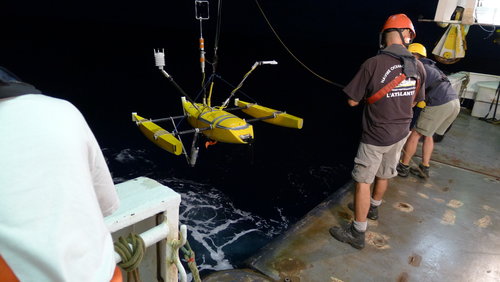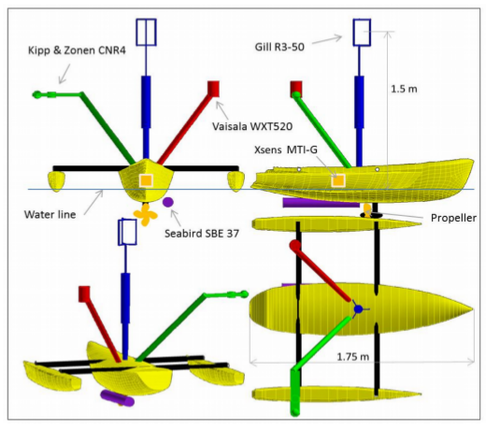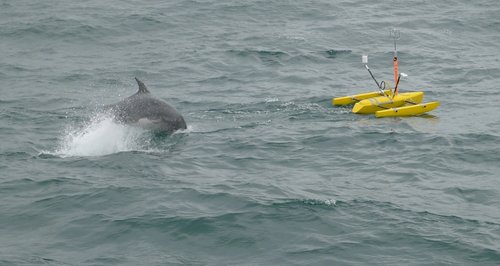The OCARINA Trimaran
The OCARINA (Océan Couplé à l'Atmosphère, Recherche sur l'Interface sur Navire Annexe) platform is a naval surface drone developed specifically to measure turbulent and radiative exchanges at the ocean/atmosphere interface.
Designed and built at LATMOS in 2009, the initial version of OCARINA has evolved through campaigns and collaborations with DT-INSU, Ifremer, LOCEAN and IRPHE.

Night-time deployment of the OCARINA trimaran, from the aft gantry of the Atalante (Genavir/Ifremer), 2012
Onboard instruments include an inertial unit, a GPS, a sonic anemometer, a probe for measuring upward and downward radiative flux in the infrared and visible wavelengths, a CT-type submerged probe, and a weather station.

The OCARINA platform is used as a drifting buoy, located by SPOT beacon or Iridium modem. It is deployed for ten-hour periods from a zodiac or from the stern gantry of an oceanographic vessel. Data are stored on SD cards.
OCARINA has been deployed on several campaigns, including FROMVAR 2011 (L. Marié, Ifremer), STRASSE 2012 (G. Reverdin), AMOP 2014 (B. Dewitte), and BBWAVES 2015 and 2016 (F. Ardhuin).
OCARINA is complementary to measurement masts on the bow of oceanographic vessels. Its advantage is that it causes very little disturbance to its environment, and provides an estimate of the sea state, as the platform follows the movement of the waves. The disadvantages are limited autonomy (10 hours) and the inability to cope with strong sea states. To date, we have obtained measurements in conditions of up to 12 m/s wind and 3.5 m swell.
Level 2 data provided includes :
- location, speed, course plotted and course taken
- height and significant period of waves longer than two meters
- water temperature (SST) at a depth of 30 cm
- surface salinity (SSS)
- meteorological variables (wind modulus and direction, temperature, humidity and pressure) at a height of one meter.
- solar and infrared upwelling and downwelling fluxes
- turbulent bulk fluxes (u*, Hs and LE), and the Monin-Obukhov ratio (z/L)
- u* and Hsv (the turbulent buoyancy flux) estimated by the inertial-dissipative method
- u* and Hsv estimated by the covariance method

References
- Bourras, D., Cambra, R., Marié, L., Bouin, M.-N., Baggio, L., Branger, H., et al. (2019). Air-sea turbulent fluxes from a wave-following platform during six experiments at sea. Journal of Geophysical Research: Oceans, 124, 4290–4321. https://doi.org/10.1029/2018JC014803
- Sentchev, A., M. Yaremchuk, D. Bourras, I. Pairaud, and P. Fraunié, 2023: Estimation of the Eddy Viscosity Profile in the Sea Surface Boundary Layer from Underway ADCP Observations. J. Atmos. Oceanic Technol., 40, 1291–1305, https://doi.org/10.1175/JTECH-D-22-0083.1.
- Bourras, D., H. Branger, G. Reverdin, L. Marié, R. Cambra, L. Baggio, C. Caudoux, G. Caudal, S. Morisset, N. Geyskens, D. Hauser, A. Weill, D. Hauser, 2014. A new platform for the determination of Air-Sea Fluxes (OCARINA) : overview and first results. J. Atmos. Oceanic Technol., 31, 1043–1062. doi : http://dx.doi.org/10.1175/JTECH-D-13-00055.1.
- Cambra, R., Etude des flux turbulents à l’interface air-mer à partir de données de la plateforme OCARINA. Thèse de doctorat de l’université de Versaille Saint-Quentin-en-Yvelines, 320 pages, soutenue le 4 décembre 2015.

